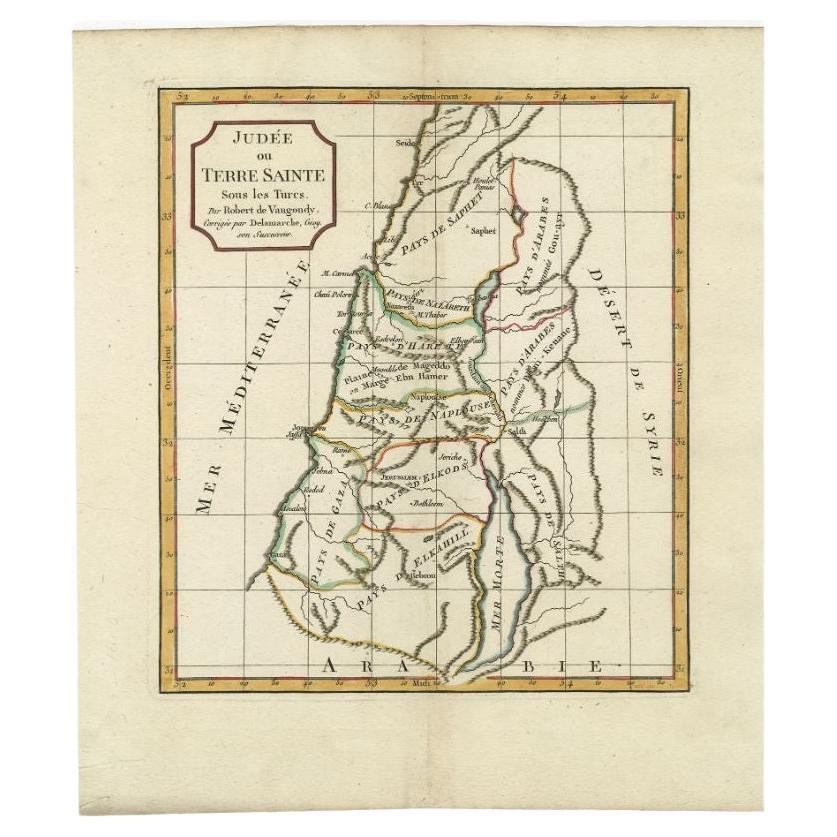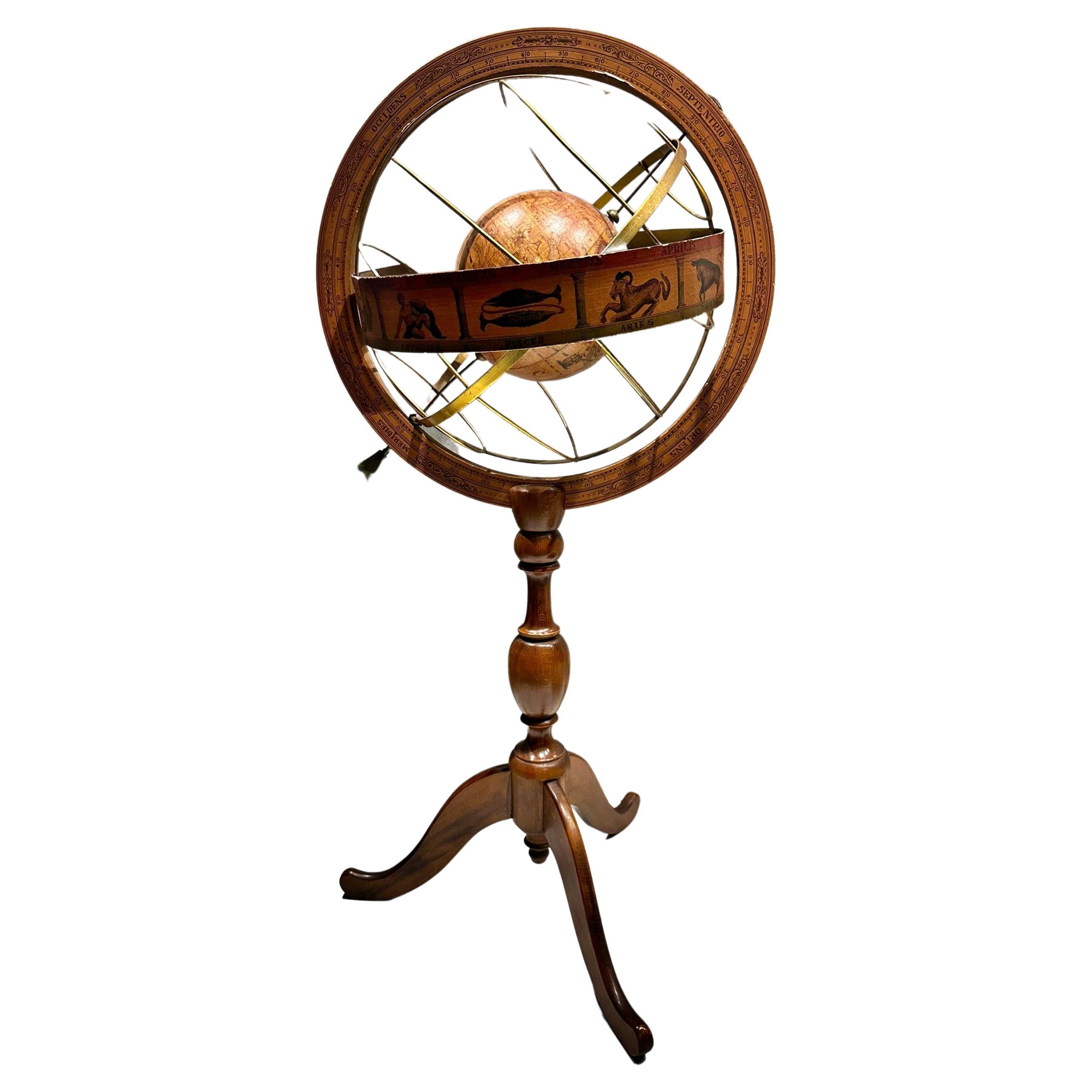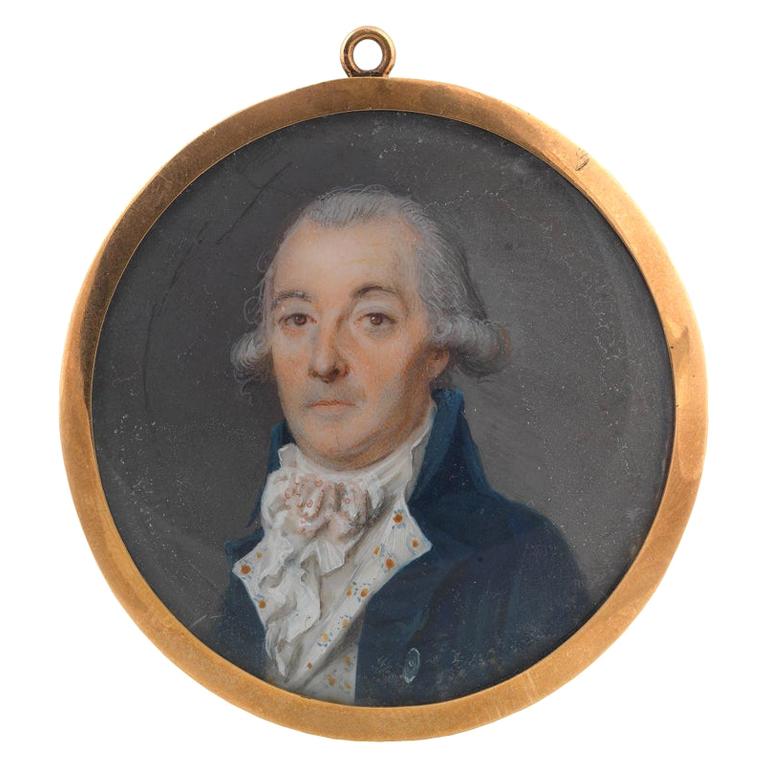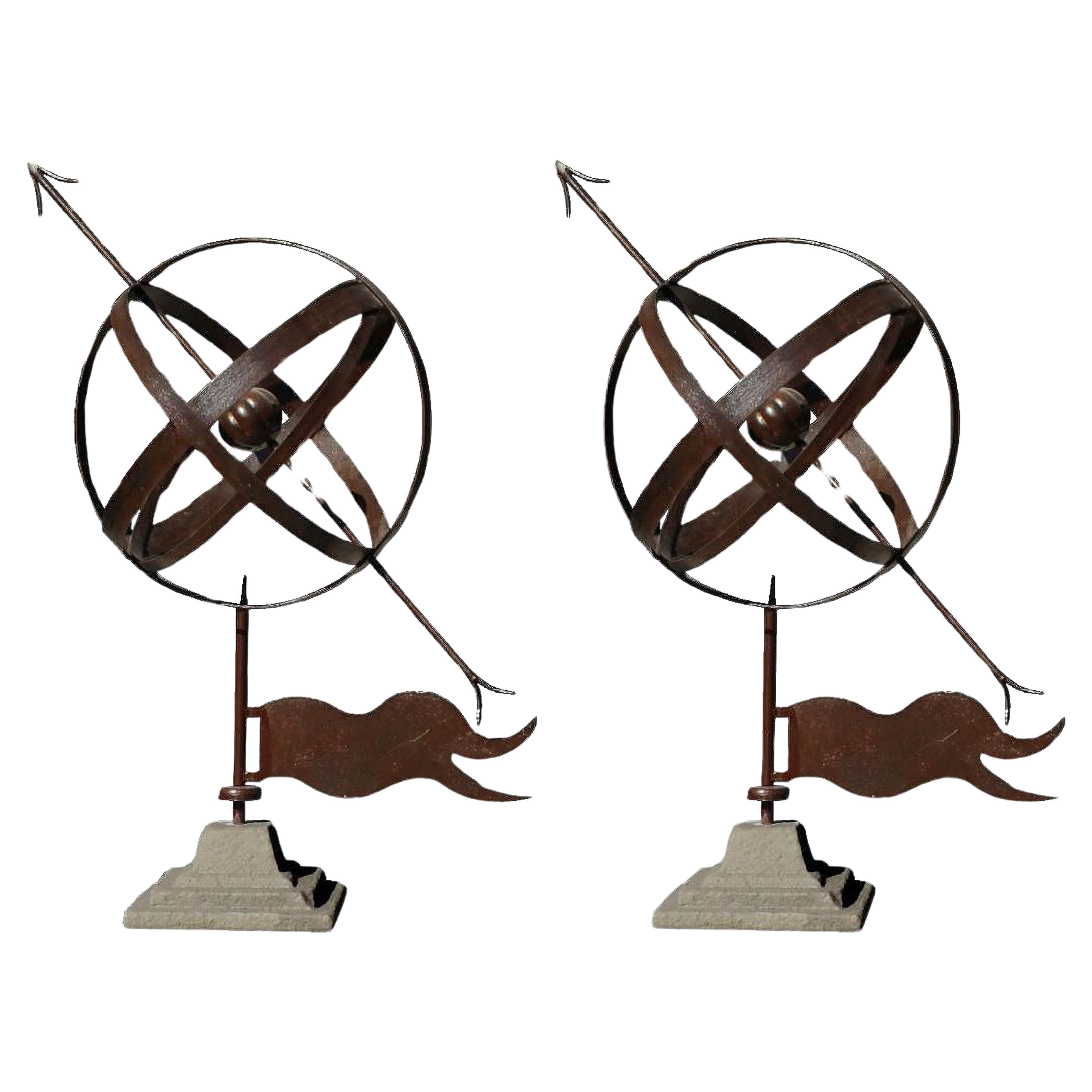Items Similar to Ptolemaic Armillary Sphere Charles-François Delamarche Paris, 1805-1810 Circa
Video Loading
Want more images or videos?
Request additional images or videos from the seller
1 of 22
Ptolemaic Armillary Sphere Charles-François Delamarche Paris, 1805-1810 Circa
About the Item
Charles-François Delamarche
Ptolemaic armillary sphere
Paris, circa 1805-1810
Wood and papier-mâché
covered with printed and partly hand-coloured paper
It measures 15.74” in height, 11.02” in diameter (40 – Ø 28 cm)
2.052 lb (931 g)
State of conservation: some abrasions and signs of use; some spots. The small ring at the peak of the sphere is illegible.
The small central globe bears the following inscription in the Pacific Ocean, west of South America:
Globe Terrestre
à Paris
chez Delamarche géog
rue de Jardinet
N°. 13
The sphere is Ptolemaic, with the Earth placed at its centre; two discs, representing the Moon and the Sun, rotate around the terrestrial globe.
The sphere is composed of six horizontal and two vertical rings (armillae), each bearing graduations and its own name.
The first horizontal ring is illegible. The others, in descending order are: North Pole, Tropic of Cancer, Equator, Tropic of Capricorn, South Pole.
The vertical rings consist of two double meridians.
The sphere is then connected to the large meridian by two pins, a vertical ring inserted perpendicularly into the circle of the Horizon, in turn supported by four semicircles connected to the turned and black-stained wooden base.
Each element is covered with printed paper. It contains various pieces of information: latitudes, length of days, names and zodiac symbols, calendar, wind directions, etc.
The vertical circles mention the latitudes and longitudes of different cities: Rome, Bordeaux, Madrid, Boston, Batavia (Jakarta), Acapulco, etc.
Even the small terrestrial globe is covered with printed paper: continents and oceans appear with numerous geographical markings indicating the most recent explorations.
The North American coasts are well delineated and California appears correctly as a peninsula - reports from Spanish explorers in the region had given rise to confusion as to whether it was connected to the mainland or not. The geographical nature of California was confirmed after the explorations of Juan Bautista de Anza (1774-1776).
Alaska is not described and is only partially traced; it would become part of the United States in 1867.
Various Pacific islands are indicated.
Australia (the name definitely used from 1824) is called "Nouvelle Hollande".
Tasmania is still represented as a peninsula and this is an important detail for the dating of our armillary sphere.
The island is separated from Australia by Bass Strait, which was crossed by Matthew Flinders for the first time in 1798, showing that it was not a peninsula. Delamarche certainly would not have waited a long time to update such an important geographical datum: presumably he did shortly after 1805, when he moved the business to rue du Jardinet n. 13.
Charles-François Delamarche (1740-1817) founded his laboratory around 1770 and, in a few years, he became the most famous French cartographer and globe maker between the 18th and 19th centuries. After having acquired the laboratory of the late Didier Robert de Vaugondy (1723-1786; himself a renowned cartographer who continued the family business founded by his grandfather Nicolas Sanson in the seventeenth century) and after having purchased, between 1788 and around 1800, the businesses of Jean-Baptiste Fortin (1750-1831) and Jean Lattré (around 1750-1800), he began to call himself "Successeur de MM. Sanson and Robert de Vaugondi, Géographes du Roi and de M. Fortin, Ingénieur-mécanicien du Roi pour les globes et les sphères".
Thus, at the end of the eighteenth century, Delamarche possessed the warehouse stocks, as well as the manufacturing skills of the globes of his main rivals in Paris.
In addition to this aggressive acquisition policy, the key to his success also lay in the combination of high-quality cartography combined with extremely attractive globes and armillary spheres; and, of course, its famous red paint finishing touch.
His laboratory was located in Rue de Foin St Jacques "au Collège Me. (or "Mtre") Gervais" in the Latin Quarter of Paris until around 1805, when he moved to rue du Jardinet n. 13.
On the death of Charles-François in 1817, the reins of the company passed to his son Félix (1779-1835), who continued to publish, often in collaboration with the engraver Charles Dien, Senior. In 1835 the company first moved to rue du Jardinet n. 12 and a little later to rue du Battoir n. 7.
Bibliography:
- Dekker, Elly, et al. Globes at Greenwich: A Catalogue of the Globes and Armillary Spheres in the National Maritime Museum, Greenwich, London, Oxford University Press and the National Maritime Museum, 1999, pp. 321-322 for the history of the Delamarche business;
- Van der Krogt P. e Dekker E., Globes from the Western World, Londra 1993, p. 78;
- Van der Krogt P., Old Globes in the Netherlands, Utrecht 1984, pp. 98-99.
- Creator:Charles Francois Delamarche (Maker)
- Dimensions:Height: 15.75 in (40 cm)Diameter: 11.03 in (28 cm)
- Style:Empire (Of the Period)
- Materials and Techniques:
- Place of Origin:
- Period:
- Date of Manufacture:circa 1810
- Condition:Wear consistent with age and use. Minor losses. Some abrasions and signs of use; some spots. The small ring at the peak of the sphere is illegible.
- Seller Location:Milano, IT
- Reference Number:1stDibs: LU4352219672472
About the Seller
4.3
Vetted Seller
These experienced sellers undergo a comprehensive evaluation by our team of in-house experts.
Established in 1860
1stDibs seller since 2018
19 sales on 1stDibs
Typical response time: 6 hours
Associations
International Confederation of Art and Antique Dealers' Associations
- ShippingRetrieving quote...Ships From: Milano, Italy
- Return PolicyA return for this item may be initiated within 14 days of delivery.
More From This SellerView All
- Terrestrial Table Globe by Félix Delamarche, Paris, 1821By Félix DelamarcheLocated in Milano, ITTerrestrial table globe Félix Delamarche Paris, 1821 It measures 20.47 in height, Ø max 14.17 in; the sphere Ø 9.44 in (h 52 cm x Ø max 36.5 cm; the sphere Ø 24 cm) Wood, printed...Category
Antique 1820s French Restauration Scientific Instruments
MaterialsMetal
- English Pocket Globe, London, Circa 1775-1798By Herman MollLocated in Milano, ITPocket globe London, between 1775 and 1798 Re-edition of the globe of Hermann Moll (1678-1732) dated 1719 The globe is contained in its original case, which itself is covered in sh...Category
Antique Late 18th Century English George III Globes
MaterialsShagreen, Paper
- German Globe by C. Abel-Klinger, Nuremberg, circa 1860By C. Abel-KlingerLocated in Milano, ITTerrestrial globe Artistic company C. Abel - Klinger Nuremberg, circa 1860 H cm 31 x 22 cm (12.20 x 8.66 in); sphere 14 cm (5.51 in) in diameter lb 2.30 (kg 1.04) State of conservation: good. On the sphere there are slight visible signs of accidental bumping at the poles, as well as on New Guinea and England (vertical and more visible); some ink stains, especially at the South Pole and on the meridian that crosses North America. The globe is composed of twelve whole gores of printed paper, juxtaposed and glued on a sphere made with a chalky base mixture. The circle of the meridian, made of brass...Category
Antique 1860s German Other Scientific Instruments
MaterialsWood, Paper
- 19th Century Italian Wood Mannequin, Circa 1870-1880Located in Milano, ITMannequin Sculpted and carved wood Italy or France, second half of the 19th century. It measures 25.59 x 6.29 x 3.54 in (65.5 x 16 x 9 cm) It weighs 2.2 lb circa (1 kg circa) St...Category
Antique 1870s Italian Other Figurative Sculptures
MaterialsWood
- Late 19th Century Italian Wood Mannequin, circa 1880Located in Milano, ITAtelier mannequin graven and carved stone pine wood Italy, late 19th century Measures: H 102 cm x 25 cm x 14 cm H 40.15 in x 9.84 in x 5.51 in Weight: circa kg 4 State of conse...Category
Antique 1880s Italian Other Figurative Sculptures
MaterialsWood
- Pair of English 12-inch Globes by William Harris, London, 1832 and 1835By William HarrisLocated in Milano, ITPair of 12-inch table globes William Harris London, 1832 and 1835 Slight abrasions from use; few cracks lb 11 each (kg 5) The two terrestrial and celestial globes rest in their original Dutch style stands with four supporting turned wood columns. Each one measures 12 in in height x 16.5 in in diameter with the diameter of the spheres measuring approximately 12 in; 48 cm in height x 42 cm in diameter x 31 cm diameter of the spheres. The 12 inch measure was the most frequently used by British manufacturers of globes of this period. Each globe is composed of two series of twelve printed paper gores, aligned and glued onto plaster spheres. The brass circle of the meridian bears engravings...Category
Antique 1830s English William IV Globes
MaterialsPaper, Wood
You May Also Like
- Exclusive Antique Armillary SphereLocated in Vlimmeren, BEAn armillary sphere is a model of objects in the sky consisting of a spherical framework of rings, centred on the Earth or the Sun, that represent lin...Category
Antique Mid-19th Century European Industrial Scientific Instruments
MaterialsMetal
- Antique Map of the Holy Land by Delamarche, 1806By Charles Francois DelamarcheLocated in Langweer, NLAntique map titled 'Judee ou Terre Sainte sous les Turcs.' This map shows the holy land under the Turcs. By Robert de Vaugondy, revised and published by ...Category
Antique 19th Century Maps
MaterialsPaper
- Impressive and Ancient Italian Armillary Sphere from Early 20th CenturyBy Europa AntiquesLocated in Madrid, ESImpressive and Ancient Italian Armillary Sphere from early 20th century, handcrafted in wood and metal/golden brass with a base on 3 solid wood legs. Certificate of authenticity....Category
Early 20th Century Italian Baroque Nautical Objects
MaterialsIron
- Portrait Miniature American School, circa 1805Located in Firenze, ITSHIPPING POLICY: No additional costs will be added to this order. Shipping costs will be totally covered by the seller (customs duties included). A Gentleman, wearing dark blue coat...Category
Antique Early 1800s American American Classical Models and Miniatures
MaterialsGold
- Pair of Italian Armillary Spheres Vane began 20th Century H: 80cmBy Europa AntiquesLocated in Madrid, ESPair of Italian Armillary Spheres Vane began 20th Century material: iron and stone HEIGHT 80 cm DIAMETER 60 cm WIDTH 60 cm DEPTH 85 cm good conditionsCategory
Early 20th Century Italian Modern Nautical Objects
MaterialsStone, Iron
- French Late 19th Century Bronze Armillary Sphere Depicting the Titan AtlasLocated in Atlanta, GAA French bronze armillary sphere depicting Atlas carrying the world from the late 19th century with verdigris patina. Created in France during the last quarter of the 19th century, this bronze armillary sphere showcases a mythological theme depicting the famed Titan Atlas, condemned to carry the sky on his shoulders for eternity. How appropriate then, to choose him to carry effortlessly this armillary! Casually placing his left hand on his waist, Atlas raises the sphere made of various connecting rings...Category
Antique Late 19th Century French Scientific Instruments
MaterialsBronze
Recently Viewed
View AllMore Ways To Browse
Early California Furniture
Late 18th And Early 19th Century French Furniture
Charles 18th Century French Furniture
Ring Insert
French Pole
Important Early Ring
Hand Turned Wood Signed
Old Wood Cross
Wooden Sphere
Terrestrial Globe
Vertical Antique Sign
Early American Furniture 1800
Antique Black Wood Stain
E Globe
19th Century Australian Furniture
North Pole
Used Furniture Key West
Terrestrial Globes





